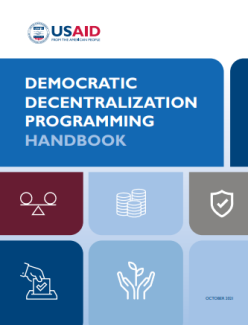The Democratic Decentralization Programming Handbook conceptualizes decentralization as a reform that advances democracy and development in a context of stability and the rule of law. Decentralization invests new actors with public responsibilities. The newly involved actors that decentralization empowers (or “should” empower) include appointed officials in subnational administrations, elected officials in subnational governments, and increasingly engaged citizens themselves. For the purposes of this Handbook, decentralization is defined as the transfer of power from national governments to subnational governments or to the subnational administrative units of national governments. This definition is useful because it allows a discussion of decentralization’s two most common forms, deconcentration and devolution, without privileging one over the other.
At its core, decentralization increases the ability of local governments to provide valued services, which it does by changing rather than eliminating the role of the central government. Decentralization’s promise is often accompanied by shortcomings, perils, and unforeseen consequences. While in many cases it has not yet fixed the problems it was adopted to help resolve, decentralization is not a “one-shot” experience, but rather a more iterative process that takes time to unfold and deliver on its many promises.
This Handbook is designed to provide a theoretically-informed and empirically-supported foundation for USAID officers undertaking work in missions around the world. Chapter 1 provides an introduction to key concepts in decentralization, including its main dimensions, goals, and arenas. Chapter 2 further describes the primary dimensions and forms of decentralization; while Chapter 3 elaborates the three major goals that countries often pursue through decentralization. Chapters 4 and 5 are structured around the most important arenas in which USAID is likely to intervene. Specifically, Chapter 4 provides guidance about how to assess the national, subnational, and civil society environment in a given country; and Chapter 5 presents programming strategies that are targeted for each of these three arenas. Chapter 6 describes how USAID can reliably evaluate decentralization programs and learn from its experience. Chapter 7 presents concluding comments.

